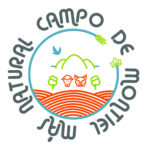Wilder Campo de Montiel
Campo de Montiel más Natural
Campo de Montiel is a ca. 600,000 ha region located in Central Spain, which represents a continental Mediterranean agricultural and forest/shrubland mosaic. Iconic species such as the Iberian lynx, the Iberian imperial eagle and the Great bustard thrive in the region, which holds a considerable amount of natural protected areas. It is also a migratory pass way for birds. This region is also rich in native domesticated biodiversity and culture (e.g. it is Don Quijote´s land), part of which is strongly linked to the natural heritage (transhumance, extensive sheep and goat grazing, sustainable agricultural practices, traditional hunting, gastronomy). However, land use intensification (e.g. agriculture and hunting), which has already occurred at a considerable extent, and new mining projects threaten Campo de Montiel. Some relevant species such as the Bonelli´s eagle do not nest anymore in the area or are declining.
We pursue enhancing wildlife at the landscape scale, in a respectful manner with the local inhabitants, and think that these actions may bring up new economic opportunities. To achieve this goal, we will trigger and spread conservation and restoration actions that, together with the best practices of land use, enhance biodiversity and human well-being in the region, including a new economy and nature-based businesses. We aim to restore (1) dispersion and connectivity, (2) natural disturbances, (3) trophic networks, and (4) environmental heterogeneity. A relevant specific objective is to bring back species such as the Bonelli´s eagle and to recover the populations of sharply declining species such as the Little bustard and Montagu’s Harrier. We pursue as well merging the enhanced natural heritage with the cultural heritage and create sense of place.
- Restored natural processes
- A more sustainable farmland environment
- New established nature-based businesses
- Assisted colonization of Bonelli´s eagle and Black vulture
- Increased populations of the reintroduced Iberian lynx and of the Iberian imperial eagle, Montagu's Harrier, Little bustard and other steppe-like habitat bird species
FIRE has been developing individual, relatively small projects in the region since 2010; the main ones are the "Fields for Life", "Gardens for Life", "Green Road Links and Roundabouts", and “Singular Fruit Trees” projects. The Fields for Life project has implemented a number of actions such as hedgerow planting (1,800 m), pond construction (15), and installation of nest-boxes for different bird species (74) and perches (43), which are mostly intended to enhance wildlife in the farmed environment. Gardens for Life is a naturalistic gardening project implemented in one site. The Green Road Links and Roundabouts project has been implemented in one site as well, and it mostly consists on revegetating these "empty" spaces around towns. The Singular Fruit Tree project has propagated a magnificent > 200-yr-old almond tree and planted new seedlings from it. FIRE has performed training, volunteering, communication, and education actions related to the mentioned projects. It has also conducted research related to bird communities (nocturnal birds and birds within and around the tree plantations) in the region, and monitoring of plants and mammals.

Campo de Montiel is a ca. 600,000 ha region located in Central Spain, which represents a continental Mediterranean agricultural and forest/shrubland mosaic. Iconic species such as the Iberian lynx, the Iberian imperial eagle and the Great bustard thrive in the region, which holds a considerable amount of natural protected areas. It is also a migratory pass way for birds. This region is also rich in native domesticated biodiversity and culture (e.g. it is Don Quijote´s land), part of which is strongly linked to the natural heritage (transhumance, extensive sheep and goat grazing, sustainable agricultural practices, traditional hunting, gastronomy). However, land use intensification (e.g. agriculture and hunting), which has already occurred at a considerable extent, and new mining projects threaten Campo de Montiel. Some relevant species such as the Bonelli´s eagle do not nest anymore in the area or are declining.
We pursue enhancing wildlife at the landscape scale, in a respectful manner with the local inhabitants, and think that these actions may bring up new economic opportunities. To achieve this goal, we will trigger and spread conservation and restoration actions that, together with the best practices of land use, enhance biodiversity and human well-being in the region, including a new economy and nature-based businesses. We aim to restore (1) dispersion and connectivity, (2) natural disturbances, (3) trophic networks, and (4) environmental heterogeneity. A relevant specific objective is to bring back species such as the Bonelli´s eagle and to recover the populations of sharply declining species such as the Little bustard and Montagu’s Harrier. We pursue as well merging the enhanced natural heritage with the cultural heritage and create sense of place.

- Restored natural processes
- A more sustainable farmland environment
- New established nature-based businesses
- Assisted colonization of Bonelli´s eagle and Black vulture
- Increased populations of the reintroduced Iberian lynx and of the Iberian imperial eagle, Montagu's Harrier, Little bustard and other steppe-like habitat bird species
FIRE has been developing individual, relatively small projects in the region since 2010; the main ones are the "Fields for Life", "Gardens for Life", "Green Road Links and Roundabouts", and “Singular Fruit Trees” projects. The Fields for Life project has implemented a number of actions such as hedgerow planting (1,800 m), pond construction (15), and installation of nest-boxes for different bird species (74) and perches (43), which are mostly intended to enhance wildlife in the farmed environment. Gardens for Life is a naturalistic gardening project implemented in one site. The Green Road Links and Roundabouts project has been implemented in one site as well, and it mostly consists on revegetating these "empty" spaces around towns. The Singular Fruit Tree project has propagated a magnificent > 200-yr-old almond tree and planted new seedlings from it. FIRE has performed training, volunteering, communication, and education actions related to the mentioned projects. It has also conducted research related to bird communities (nocturnal birds and birds within and around the tree plantations) in the region, and monitoring of plants and mammals.


